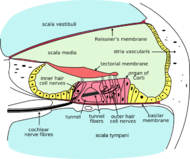Sensorineural hearing loss
 From Wikidoc - Reading time: 4 min
From Wikidoc - Reading time: 4 min
| Sensorineural hearing loss | |
 | |
|---|---|
| Cross section of the cochlea. | |
| ICD-10 | H90.3-H90.5 |
| ICD-9 | 389.1 |
| DiseasesDB | 2874 |
| MeSH | D006319 |
Editor-In-Chief: C. Michael Gibson, M.S., M.D. [1]
Overview[edit | edit source]
Sensorineural hearing loss is a type of hearing loss in which the root cause lies in the vestibulocochlear nerve (Cranial nerve VIII), the inner ear, or central processing centers of the brain.
The Weber test, in which a tuning fork is touched to the head, localizes to the normal ear in people with this condition.
The Rinne test, which tests air conduction vs. bone conduction is positive (normal), though both bone and air conduction are reduced equally.
Differential diagnosis[edit | edit source]
Sensorineural hearing loss may be congenital or acquired.
Congenital[edit | edit source]
- Lack of development (aplasia) of the cochlea
- Chromosomal syndromes (rare)
- Congenital cholesteatoma - squamous epithelium is normally present on either side of the tympanic membrane. Externally, within the external auditory meatus or ear canal and internally within the middle ear. Within the middle ear the simple epithelium gradually transitions into ciliated pseudostratified epithelium lining the Eustachian tube now known as the pharyngotympanic tube becoming continuous with the respiratory epithelium in the pharynx. The squamous epithelium hyperplasia within the middle ear behaves like an invasive tumour and destroys middle ear structures if not removed
- Delayed familial progressive
Acquired[edit | edit source]
- Inflammatory
- Suppurative labyrinthitis
- Meningitis
- Mumps
- Measles
- Viral
- Syphilis
- Ototoxic drugs
- Aminoglycosides (most common cause; e.g., tobramycin)
- Loop diuretics (e.g., Furosemide)
- Antimetabolites (e.g., Methotrexate)
- Salicylates (e.g., Aspirin)
- Physical trauma - either due to a fracture of the temporal bone affecting the cochlea and middle ear, or a shearing injury affecting cranial nerve VIII.
- Noise-induced - prolonged exposure to loud noises (>90 dB) causes hearing loss which begins at 4000Hz (high frequency). The normal hearing range is from 20 Hz to 20,000 Hz.
- Presbyacusis - age-related hearing loss that occurs in the high frequency range (4000Hz to 8000Hz).
- Sudden hearing loss
- Idiopathic (ISSHL: idiopathic sudden sensoneurinal hearing loss), H91.2, German Wikipedia: "Hörsturz"
- Vascular ischemia of the inner ear or CN 8
- Perilymph fistula, usually due to a rupture of the round or oval windows and the leakage of perilymph. The patient will most likely also experience vertigo or imbalance. A history of an event that increased intracranial pressure or caused trauma is usually present).
- Autoimmune - a prompt injection of steroids into ear is necessary.
- Cerebellopontine angle tumour (junction of the pons and cerebellum) (the cerebellopontine angle is the exit site of both CN7 and CN8. Patients with these tumours often have signs and symptoms corresponding to compression of both nerves)
- Acoustic neuroma (Vestibular schwannoma) - this is a schwannoma (benign neoplasm of Schwann cells)
- Meningioma - benign tumour of the pia and arachnoid maters
- Meniere's disease - causes sensorineural hearing loss in the low frequency range (125 Hz to 1000 Hz). Meniere's disesase is characterized by sudden attacks of vertigo lasting minutes to hours preceded by tinnitus, aural fullness, and fluctuating hearing loss.
Table 1. A table comparing sensorineural to conductive hearing loss
| Criteria | Sensorineural hearing loss | Conductive hearing loss |
| Anatomical Site | Inner ear, cranial nerve VIII, or central processing centers | Middle ear (ossicular chain), tympanic membrane, or external ear |
| Weber Test | Sound localizes to normal ear | Sound localizes to affected ear (ear with conductive loss) |
| Rinne Test | Positive Rinne; Air conduction > Bone conduction (both air and bone conduction are decreased equally, but the difference between them is unchanged). | Negative Rinne; Bone Conduction > Air Conduction (Bone/Air Gap) |
Treatment[edit | edit source]
At present, sensorineural hearing loss is treated with hearing aids, which amplify sounds at pre-set frequencies to overcome a sensorineural hearing loss in that range; or cochlear implants, which stimulate the cochlear nerve directly.
Resources[edit | edit source]
- Sensorineural Hearing Loss, Dr Peter Grant
 KSF
KSF